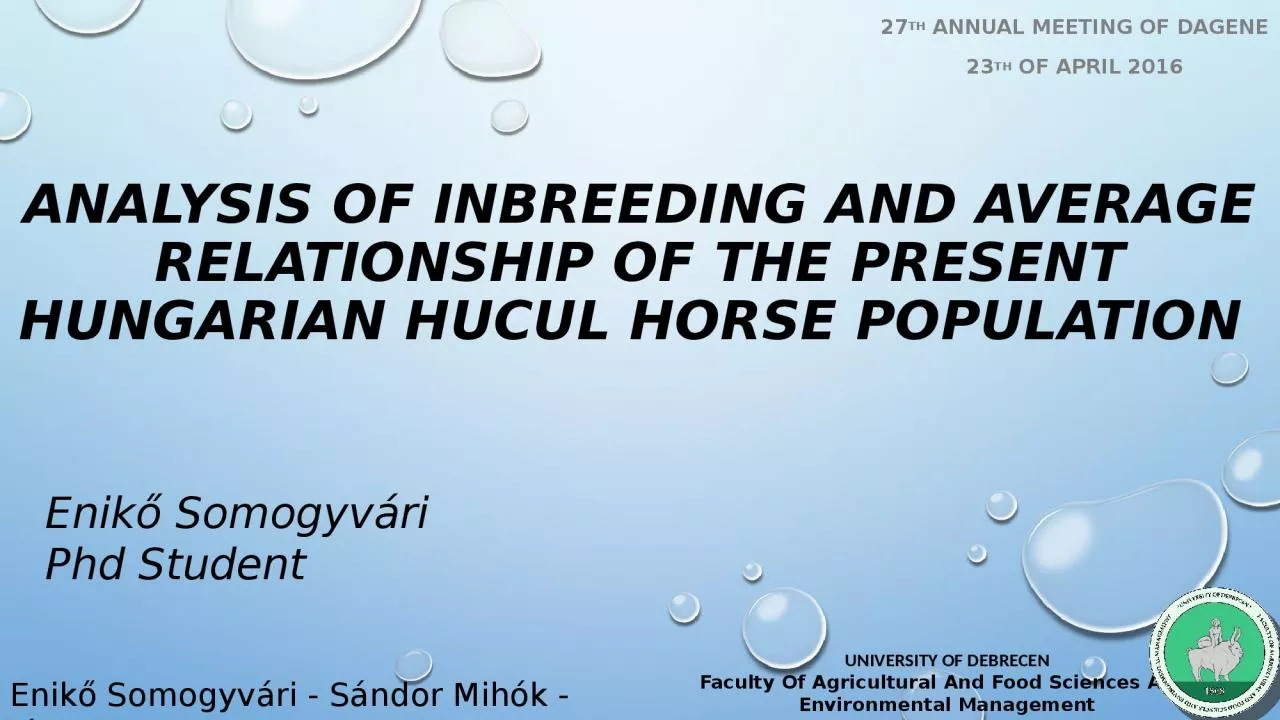

27 th Annual Meeting of DAGENE 2 3 th of April 2016 Enikő Somogyvári Phd Student Enikő Somogyvári Sándor Mihók János Posta UNIVERSITY OF DEBRECEN Faculty Of ID: 930716
Download Presentation The PPT/PDF document "Analysis of inbreeding and average relat..." is the property of its rightful owner. Permission is granted to download and print the materials on this web site for personal, non-commercial use only, and to display it on your personal computer provided you do not modify the materials and that you retain all copyright notices contained in the materials. By downloading content from our website, you accept the terms of this agreement.
Slide1
Analysis of inbreeding and average relationship of the present Hungarian Hucul Horse population
27th Annual Meeting of DAGENE23th of April 2016
Enikő Somogyvári Phd Student
Enikő Somogyvári - Sándor Mihók - János Posta
UNIVERSITY OF DEBRECENFaculty Of Agricultural And Food Sciences And Environmental Management
Slide2Introduction
the genetic structure of the Hungarian Hucul population based on pedigree data (population genetic methods). in small population Examinations increasingly justified and frequent.These calculations help in the breeding programmes. They may set the directions or even the extent of the modifications. the necessity of sustaining diversity within the populations, avoid close breeding or suggest mating systems.
Slide3Material and methods
the pedigree information of the Hungarian Hucul Horse.Pedigree information of the breed up to 2015. 2015 as reference population. the pedigree information of 3,002 horses. The inbreeding coefficient, average relatedness Endog software (GUTIÉRREZ AND GOYACHE, 2005).
Slide4Material and methods
The Endog software calculates using WRIGHT’s formula (1922) where the inbreeding coefficient of a given individual (X) is:FX = Σ(1/2)n+n’+1 × (1+FA) The Endog software calculates average relatedness with an algorithm made by COLLEAU (2002). It shows the likelihood of an allele randomly chosen from the pedigree characterising the whole population belonging to an individual.
Slide5Results
Slide6Average inbreeding coefficients of mare families
The smallest inbreeding 4.62% (Aspiráns) Followed by ‘17 Aglaia’ (11.35%), ‘2 Lucina’ (10.05%) The highest inbreeding 14.78% (3 Tatarca) The total population values are below 9
Slide7Average inbreeding coefficients of stallion lines
The smallest coefficient 1.76%A few animals from the ‘Polan’ strain The highest inbreeding
10.82% ‘Pietrosu’ line
Slide8Average relatedness of mare families
Most of the families in reference population above 13% The smallest average relationship 8.35% (90 Machocha) 3 Tatarca average relationship 15.03%
Slide9Average relatedness of stallion lines
The smallest 9.4% Gurgul, 13.87% highest for the Pietrosu
Slide10Conclusion and recommendation
The increasing of the inbreeding level of the population The inbreeding coefficient of the total population 5.65%, the average relationship 10.55%. The inbreeding coefficient of the reference population 6.8%, the average relationship 12.7%. The genetic diversity of the Hungarian Hucul Horse breeding stock is favourable
Slide11Thank
you for your attention!